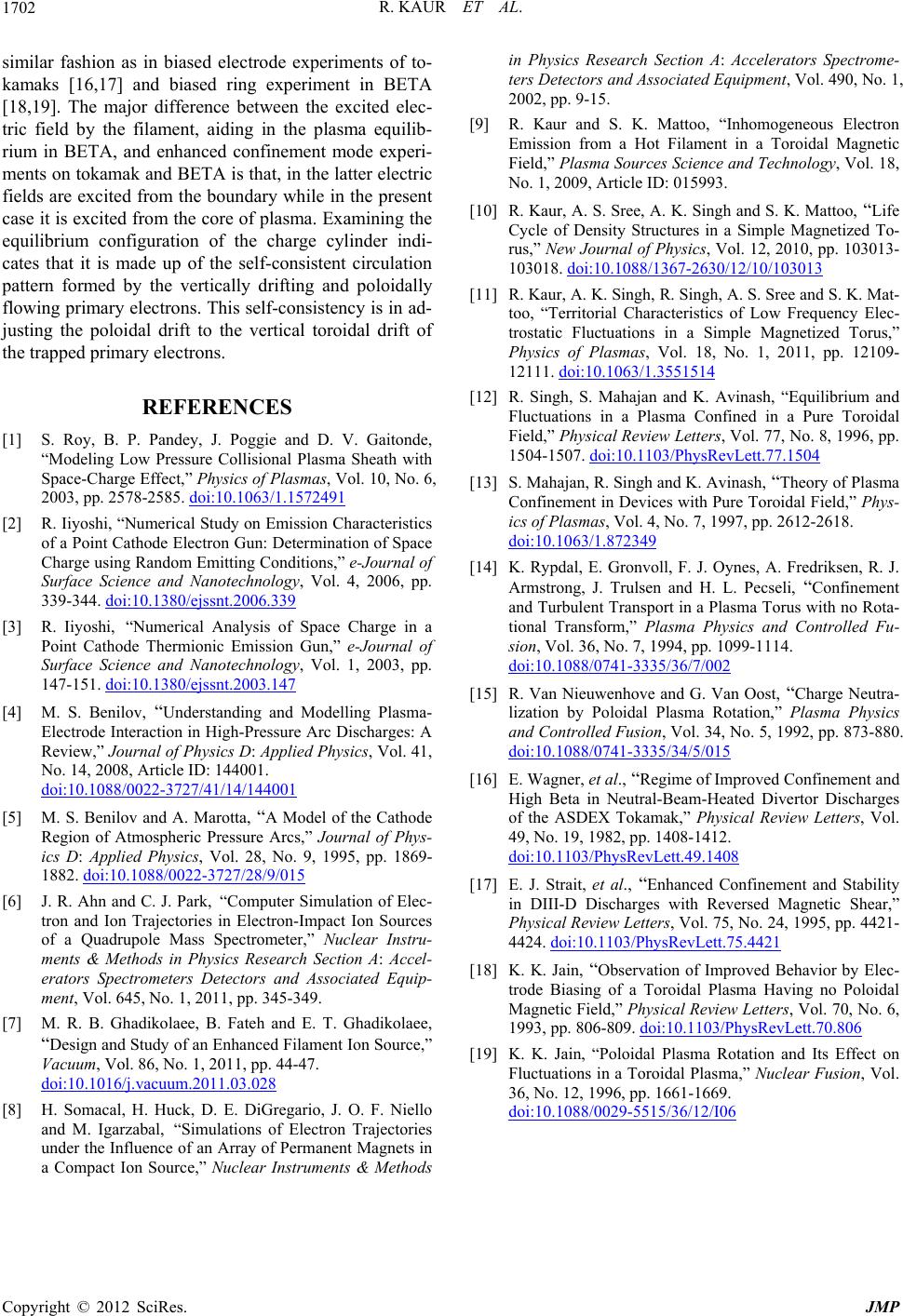
R. KAUR ET AL.
Copyright © 2012 SciRes. JMP
1702
similar fashion as in biased electrode experiments of to-
kamaks [16,17] and biased ring experiment in BETA
[18,19]. The major difference between the excited elec-
tric field by the filament, aiding in the plasma equilib-
rium in BETA, and enhanced confinement mode experi-
ments on tokamak and BETA is that, in the latter electric
fields are excited from the boundary while in the present
case it is excited from the core of plasma. Examining the
equilibrium configuration of the charge cylinder indi-
cates that it is made up of the self-consistent circulation
pattern formed by the vertically drifting and poloidally
flowing primary electrons. This self-consistency is in ad-
justing the poloidal drift to the vertical toroidal drift of
the trapped primary electrons.
REFERENCES
[1] S. Roy, B. P. Pandey, J. Poggie and D. V. Gaitonde,
“Modeling Low Pressure Collisional Plasma Sheath with
Space-Charge Effect,” Physics of Plasmas, Vol. 10, No. 6,
2003, pp. 2578-2585. doi:10.1063/1.1572491
[2] R. Iiyoshi, “Numerical Study on Emission Characteristics
of a Point Cathode Electron Gun: Determination of Space
Charge using Random Emitting Conditions,” e-Journal of
Surface Science and Nanotechnology, Vol. 4, 2006, pp.
339-344. doi:10.1380/ejssnt.2006.339
[3] R. Iiyoshi, “Numerical Analysis of Space Charge in a
Point Cathode Thermionic Emission Gun,” e-Journal of
Surface Science and Nanotechnology, Vol. 1, 2003, pp.
147-151. doi:10.1380/ejssnt.2003.147
[4] M. S. Benilov, “Understanding and Modelling Plasma-
Electrode Interaction in High-Pressure Arc Discharges: A
Review,” Journal of Physics D: Applied Physics, Vol. 41,
No. 14, 2008, Article ID: 144001.
doi:10.1088/0022-3727/41/14/144001
[5] M. S. Benilov and A. Marotta, “A Model of the Cathode
Region of Atmospheric Pressure Arcs,” Journal of Phys-
ics D: Applied Physics, Vol. 28, No. 9, 1995, pp. 1869-
1882. doi:10.1088/0022-3727/28/9/015
[6] J. R. Ahn and C. J. Park, “Computer Simulation of Elec-
tron and Ion Trajectories in Electron-Impact Ion Sources
of a Quadrupole Mass Spectrometer,” Nuclear Instru-
ments & Methods in Physics Research Section A: Accel-
erators Spectrometers Detectors and Associated Equip-
ment, Vol. 645, No. 1, 2011, pp. 345-349.
[7] M. R. B. Ghadikolaee, B. Fateh and E. T. Ghadikolaee,
“Design and Study of an Enhanced Filament Ion Source,”
Vacuum, Vol. 86, No. 1, 2011, pp. 44-47.
doi:10.1016/j.vacuum.2011.03.028
[8] H. Somacal, H. Huck, D. E. DiGregario, J. O. F. Niello
and M. Igarzabal, “Simulations of Electron Trajectories
under the Influence of an Array of Permanent Magnets in
a Compact Ion Source,” Nuclear Instruments & Methods
in Physics Research Section A: Accelerators Spectrome-
ters Detectors and Associated Equipment, Vol. 490, No. 1,
2002, pp. 9-15.
[9] R. Kaur and S. K. Mattoo, “Inhomogeneous Electron
Emission from a Hot Filament in a Toroidal Magnetic
Field,” Plasma Sources Science and Technology, Vol. 18,
No. 1, 2009, Article ID: 015993.
[10] R. Kaur, A. S. Sree, A. K. Singh and S. K. Mattoo, “Life
Cycle of Density Structures in a Simple Magnetized To-
rus,” New Journal of Physics, Vol. 12, 2010, pp. 103013-
103018. doi:10.1088/1367-2630/12/10/103013
[11] R. Kaur, A. K. Singh, R. Singh, A. S. Sree and S. K. Mat-
too, “Territorial Characteristics of Low Frequency Elec-
trostatic Fluctuations in a Simple Magnetized Torus,”
Physics of Plasmas, Vol. 18, No. 1, 2011, pp. 12109-
12111. doi:10.1063/1.3551514
[12] R. Singh, S. Mahajan and K. Avinash, “Equilibrium and
Fluctuations in a Plasma Confined in a Pure Toroidal
Field,” Physical Review Letters, Vol. 77, No. 8, 1996, pp.
1504-1507. doi:10.1103/PhysRevLett.77.1504
[13] S. Mahajan, R. Singh and K. Avinash, “Theory of Plasma
Confinement in Devices with Pure Toroidal Field,” Phys-
ics of Plasmas, Vol. 4, No. 7, 1997, pp. 2612-2618.
doi:10.1063/1.872349
[14] K. Rypdal, E. Gronvoll, F. J. Oynes, A. Fredriksen, R. J.
Armstrong, J. Trulsen and H. L. Pecseli, “Confinement
and Turbulent Transport in a Plasma Torus with no Rota-
tional Transform,” Plasma Physics and Controlled Fu-
sion, Vol. 36, No. 7, 1994, pp. 1099-1114.
doi:10.1088/0741-3335/36/7/002
[15] R. Van Nieuwenhove and G. Van Oost, “Charge Neutra-
lization by Poloidal Plasma Rotation,” Plasma Physics
and Controlled Fusion, Vol. 34, No. 5, 1992, pp. 873-880.
doi:10.1088/0741-3335/34/5/015
[16] E. Wagner, et al., “Regime of Improved Confinement and
High Beta in Neutral-Beam-Heated Divertor Discharges
of the ASDEX Tokamak,” Physical Review Letters, Vol.
49, No. 19, 1982, pp. 1408-1412.
doi:10.1103/PhysRevLett.49.1408
[17] E. J. Strait, et al., “Enhanced Confinement and Stability
in DIII-D Discharges with Reversed Magnetic Shear,”
Physical Review Letters, Vol. 75, No. 24, 1995, pp. 4421-
4424. doi:10.1103/PhysRevLett.75.4421
[18] K. K. Jain, “Observation of Improved Behavior by Elec-
trode Biasing of a Toroidal Plasma Having no Poloidal
Magnetic Field,” Physical Review Letters, Vol. 70, No. 6,
1993, pp. 806-809. doi:10.1103/PhysRevLett.70.806
[19] K. K. Jain, “Poloidal Plasma Rotation and Its Effect on
Fluctuations in a Toroidal Plasma,” Nuclear Fusion, Vol.
36, No. 12, 1996, pp. 1661-1669.
doi:10.1088/0029-5515/36/12/I06